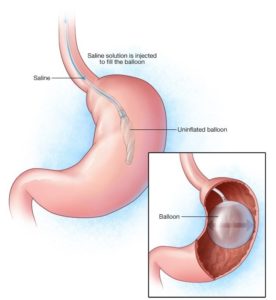Intragastric balloon
A soft, flexible catheter assembly is used to place and inflate a balloon under direct endoscopic vision. This inflated balloon fills most part of the stomach thus giving fullness and early satiety after little food intake. Patient needs to be on overnight
observation and will be discharged in a day or two.
Alternative weight loss treatment in moderately and severely obese patients. This is used in conjunction with a supervised weight loss diet program for weight loss in obese patients as a first step to reduce the surgical risks of other procedures.
An intragastric balloon may be an option for you if:
- You are overweight or class 1 obese
- You're willing to commit to healthy lifestyle changes and regular medical follow- up, as well as to participate in behavioral therapy.
- You have not had any previous stomach or oesophageal surgery.
An intragastric balloon and other weight-loss procedures or surgeries are typically done only after you've tried to lose weight by improving your diet and exercise habits. A screening process will help your doctor see if the procedure might be beneficial for you.
After a routine check gastroscopy, a deflated round, smooth silicon balloon is introduced into the stomach. 400-600 cc of saline is introduced through a self-sealing valve to facilitate simple filling. Reusable removal tools allow for deflation, fluid evacuation, capture and removal of balloon.

The patient can have small amounts of liquid starting about six hours after the procedure. The liquid diet generally continues until the start of the second week, when the patient can start eating soft foods. Regular food can be eaten around three weeks after the insertion of the intragastric balloon. Intragastric balloons are left in place for up to 12 months, and are then removed using an endoscope. Frequent meetings with members of your medical team, such as your nutritionist and psychologist, may be needed after your procedure.
